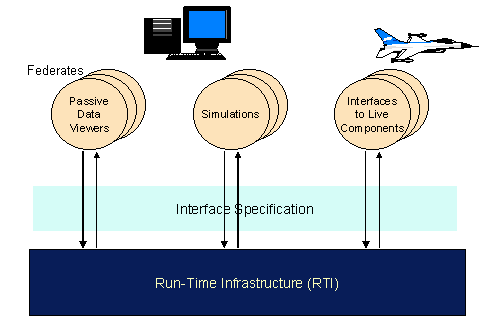
| Back | Next |
Understanding HLA
HLA is architecture for reuse and interoperation of simulations. The intent of the HLA is to provide a structure that will support reuse of capabilities available in different simulations, ultimately reducing the cost and time required to create a synthetic environment for a new purpose and providing developers the option of distributed collaborative development of complex simulation applications. Thus the HLA offers a federation approach and addresses the interoperability and reuse of individual components. In order to facilitate interoperability, each member (federate) of a distributed simulation (federation) is equipped with appropriate interfaces to interact via a run-time infrastructure. The HLA does not prescribe a specific implementation, nor does it mandate the use of any particular software or programming language.

Fig:Functional View of an HLA Federation
Key Terminologies of HLA
Federation is a composable set of interacting simulations. A federate can be a computer simulation, a manned simulator, a supporting utility, or even an interface to a live player or instrumented facility. The first key component are the simulations themselves, or more generally, the federates. All Object representation is the Federates. The HLA imposes no constraints on what is represented in the federates or how it is represented, but it does require that all federates incorporate specified capabilities to allow the objects in the simulation to interact with objects in other simulations through the exchange of data supported by services implemented in the Runtime Infrastructure (RTI). The second functional component is the RTI . The RTI is, in effect, a distributed operating system for the federation. The RTI provides a set of general-purpose services that support federate-to-federate interactions and federation management and support functions. The third component is the interface to the RTI . The HLA runtime interface specification provides a standard way for federates to interact with the RTI, to invoke the RTI services to support runtime interactions among federates and to respond to requests from the RTI. Two other general capabilities of simulation systems are supported by the architecture. First, the HLA supports the passive collection of simulation data and monitoring of simulation activities. Second, the HLA supports interfaces to live participants, such as instrumented platforms or live systems. The HLA is formally defined by three components:
HLA Interface Specification: Describes the runtime services provided to the federates by the RTI and by the federates to the RTI. There are 6 classes of service
HLA Object Models: Descriptions of the essential sharable elements of the simulation or federation in the ‘object' terms. Essentially 2 types of Object Models:
HLA Rules: Summarize key principles behind the HLA. 2 groups:
HLA Support Processes: HLA federation development and execution process (FEDEP) has been developed based in user experience with HLA. Covers 5 basic steps:
Sources: